 ,∗School of Science,
,∗School of Science, First author contact:
Received:2020-06-13Revised:2020-07-26Accepted:2020-08-11Online:2020-10-19

Abstract
Keywords:
PDF (1006KB)MetadataMetricsRelated articlesExportEndNote|Ris|BibtexFavorite
Cite this article
Lei Sun, Wei Wang. Dynamic magnetic properties of Ising graphene-like monolayer. Communications in Theoretical Physics[J], 2020, 72(11): 115703- doi:10.1088/1572-9494/abb7d0
1. Introduction
Since Novoselov et al found monolayer graphene in 2004 with flying colors [1], graphene, as one of the most promising two-dimensional structures, has given rise to widespread concern. In view of its prominent physical and chemical characters [2 –4], graphene has potential applications on chemical engineering [5], sensors [6, 7], solar cells [8] and so on. In experiment, graphene has been prepared by applying various methods. Schniepp et al successfully manufactured functionalized graphene by stripping graphite oxide and finally found that it conducts electricity [9]. By employing chemical vapor deposition, planer nano-graphene from camphor was synthesized by Somani et al [10] In addition, Lotya et al prepared graphene as well through ultrasonic treatment of graphite in surfactant or water [11]. As is well-known, pure graphene cannot display magnetic properties spontaneously. However, Yazyev found that it can exhibit magnetic properties through reducing dimensions, disorder and other possible scenarios. Besides, he also elaborated on possible physical mechanisms of magnetic properties in some systems [12]. Through electrostatic stabilization, Li et al stressed that graphene sheets would become stable aqueous colloids [13]. These meaningful findings will effectively advance the study of graphene-related materials.As a hot topic in the theoretical research of nanomaterials, mixed-spin systems have aroused wide concern and they have been used to study bimetallic molecular systems based magnetic materials. Recently, researchers have investigated the diverse mixed-spin Ising models, such as the mixed-spin (1/2, 1) nanowire [14], mixed-spin (2, 5/2) zigzag AFeII FeIII (C2 O4 )3 nanoribbons [15], mixed-spin (5/2, 2) Kekulene structure [16], mixed-spin (1, 3/2) chain with inhomogeneous crystal-field anisotropy [17], mixed-spin (3/2, 2) Ising system with two alternative layers [18], mixed-spin (2, 5/2) Ising system on a graphene layer [19], mixed-spin (3, 7/2) bilayer decorated graphene structure [20] and so on. Specially, the mixed-spin (3/2, 5/2) Ising model has drawn great attention in recent years. Jiang et al used the effective-field theory (EFT) to probe the magnetic properties of mixed-spin (3/2, 5/2) nano-graphene bilayer and found that the blocking temperature increases with decreasing the transverse field whereas it is almost unchanged when the anisotropy is strong [21]. By applying mean field theory, Mohamad studied the magnetic properties of the mixed-spin (3/2, 5/2) system under the longitudinal field and illustrated the possibility of multiple compensation temperatures [22]. Recently, Monte Carlo (MC) simulation has been widely used in the research of mixed-spin nanomaterials. Masrour et al employed MC simulation to discuss magnetic properties of mixed-spin (3/2, 5/2) nano-graphene with defects. The rate defects dependence of magnetization was investigated in detail [23]. Similarly, they also researched the effect of physical parameters such as exchange couplings and crystal fields on total magnetization, critical temperature and magnetic hysteresis behaviors [24]. The magnetic behaviors of mixed-spin (3/2, 5/2) Ising system were studied by De La Espriella et al through MC simulation. The finite-temperature phase diagrams were given and the compensation temperatures were found and discussed [25]. Using the same method, Alzate-Cardona et al investigated the magnetic characteristics of a graphene layer with mixed-spin (3/2, 5/2) [26]. It was found that the critical and compensation temperatures dramatically altered with the variation of the exchange interaction.
Since the dynamical phase transition (DPT) was found by the method of EFT for the first time [27], the research on Ising model under oscillating magnetic field has attracted more and more attention. Ertas et al employed EFT to study the dynamic magnetic properties of the ferromagnetic triangular lattice under the oscillating external magnetic field and revealed the characteristics of dynamic phase diagrams and hysteresis behaviors of the system. Moreover, they also observed and discussed the tricritical point and reentrant behaviors [28]. In addition, the authors compared their results with those of in [29] in detail. They also investigated DPT as well as dynamic phase diagrams in the Blume–Capel model [30]. Their research revealed that the thermal behaviors rely on the interaction to a great extent. In addition, Ertas also explored the dynamical thermal characteristic in the square lattice [31]. Based on EFT, the dynamic magnetic behaviors of the site diluted ferromagnetic Ising model were investigated by AkIncI et al and they observed and discussed the reentrant phenomena [32]. Similarly using EFT, Benhouria et al also investigated dynamic magnetic properties of many low-dimensional nanomaterials such as multilayer nano-graphene [33], bilayer nano-graphene [34] and C70 fullerene [35]. Additionally, Vatansever et al explored DPT in a quenched-bond diluted Ising ferromagnet and discussed dynamic properties of the different systems [36]. By means of MC simulation, Vatansever investigated DPT of the triangular lattice under an oscillating external magnetic field and found that the equilibrium system pertains to the same pervasiveness class [37]. Another interesting phenomenon that the increase of amplitude of the oscillating external magnetic field would break antiferromagnetism of the shell in nanoparticle was revealed as well, which resulted in the existence of a ground state with ferromagnetic property [38]. Moreover, Vatansever et al also stressed that the significance of the large amplitude of the oscillating external magnetic field on DPT in a spherical core–shell nanoparticle. There exist P-type, N-type and Q-type magnetic behaviors in the system under certain parametric conditions [39]. They also studied the dynamic magnetic properties of mixed-spin (1/2, 3/2) Ising ferrimagnetic system [40] and ferromagnetic thin film system [41] under an oscillating external magnetic field. Based on MC simulation, DPT in La2/3 Ca1/3 MnO3 magnets was studied by Alzate-Cardona et al and typical conclusion was illustrated. It is found that the critical temperature increases with the decreasing of the amplitude of the external magnetic field and the strong time-dependent field causes disorder and so on [42].
In our previous studies, the magnetic behaviors of various nano-systems have been studied by means of MC simulation, such as the zigzag graphene nanoribbon (GRNs) [43], ferrimagnetic mixed-spin Ising nanoisland [44], nanowires [45], nanotubes [46], graphene-like nanoisland bilayer [47], nanoparticles [48] and so on. However, little attention has been applied to the dynamic magnetic properties of Ising graphene-like monolayer under external oscillating magnetic field. The kinetic Ising model can be used to analyze various biological, chemical and physical systems from theory [49]. In addition, it plays an important role in describing experimental observations as well. The investigations of DPT can bring forth new ideas in materials manufacturing, processing and nanotechnology, for instance the monomolecular organic films [50], pattern formation [51], cuprate superconductor [52].
As a result, the purpose of this paper is to reveal and explain the magnetization, magnetic susceptibility, internal energy and phase diagram of the mix-spin (3/2, 5/2) Ising graphene-like monolayer under different Hamiltonian parameters such as crystal field and external oscillating magnetic field through MC simulation. The paper is organized as follows: section
2. Model and MC simulation
We considered a two-dimensional mixed-spin (3/2, 5/2) Ising model with graphene-like monolayer (see figure 1 ) under the time-dependent magnetic field h (t). It is composed of sublattice A (purple balls) with spin-3/2 and sublattice B (green balls) with spin-5/2. The lines connecting the sublattices represent the exchange couplings between the sublattices.Figure 1.
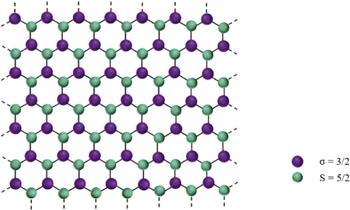 New window|Download| PPT slide
New window|Download| PPT slideFigure 1.Schematic of a ferrimagnetic mixed-spin (3/2, 5/2) Ising graphene monolayer.
The Hamiltonian of the considered system can be written as follows:
Da : the crystal field of the sublattice A.
Db : the crystal field of the sublattice B.
The spin values of the sublattices A and B are
We performed MC simulation based on the Metropolis algorithm [53] to calculate the mixed-spin Ising model with high spin values. The periodic boundary conditions were employed on a 2N2 honeycomb lattice. We carried out additional simulations to determine the system size. Figure 2 shows the temperature dependence of the susceptibility χ of the system for various system size 2N2 with fixed Da =−0.5, Db =−0.2, hb =0.5, h0 =1.0 and ω =0.008π, respectively. It is found that there exists a peak in each χ curve no matter which system size. It is worth noting that the peak corresponds to the critical temperature TC [35, 42, 54]. One can notice that the value of TC increases with the increase of 2N2 when 2N2 <2×202, which suggests that the obvious finite size effect for small size. But no significant difference was found in the peak of the χ curve when the system size 2N2 changes from 2×202 to 2×402 . Therefore, we selected the system size 2×202 in the following simulations for the sake of saving computing time because it is enough for reflecting the intrinsic properties of studied Hamiltonian. In one Monte Carlo step (MCS), each spin is swept independently and randomly. In order to get equilibrium of the system, we applied 5×105 MCS to calculate the average value of thermodynamic quantity after eliminating first 2×105 MCS at each temperature. The error bars are obtained by averaging 10 independent sample based on the Jackknife method [55, 56].
Figure 2.
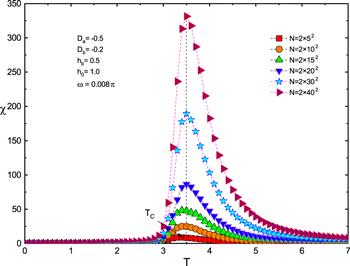 New window|Download| PPT slide
New window|Download| PPT slideFigure 2.The temperature dependence of χ for different system size 2N2 with Da =−0.5, Db =−0.2, hb =0.5, h0 =1.0, ω =0.008π .
The interested quantities are calculated as follows:
The instantaneous internal energy of the system per spin can be expressed by:
The dynamical internal energy of the system per spin can be calculated as:
The instantaneous magnetizations of the sublattice are given as:
The dynamic order parameters of the sublattices can be computed as follows:
In above equations, except the study of the effect of ω on the dynamical magnetic properties, the angular frequency of the oscillating magnetic field is taken
Therefore, the average dynamic order parameter of the system per spin is:
The susceptibility of the system is defined as:
3. Result and discussion
3.1. Dynamic order parameter, susceptibility and internal energy
Figure 3 exhibits temperature dependence of the dynamic order parameter of the systemFigure 3.
 New window|Download| PPT slide
New window|Download| PPT slideFigure 3.The temperature dependence of Qt, Qa, Qb, χ and U for different values of Da with Db =−0.2, hb =0.5, h0 =1.0, ω =0.008π .
Figure 4 shows the temperature dependence of the Qt, Qa, Qb, χ and U for diverse values of Db with Da =−0.5, hb =0.5, h0 =1.0, ω =0.008π . There are three saturation values(Qt =0.5, 0, −0.25) in figure 4 (a), which can be calculated as:
Figure 4.
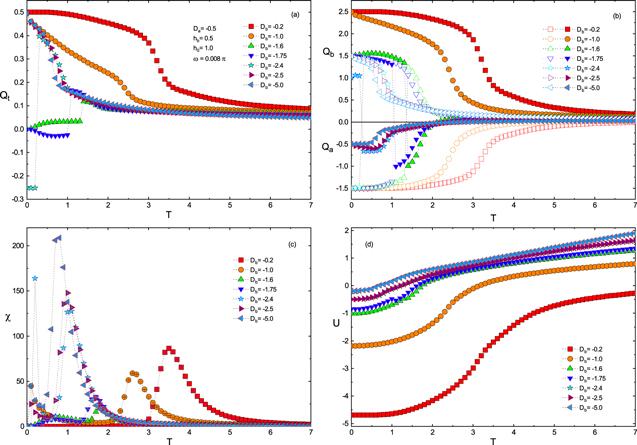 New window|Download| PPT slide
New window|Download| PPT slideFigure 4.The temperature dependence of Qt, Qa, Qb, χ and U for different values of Db with Da =−0.5, hb =0.5, h0 =1.0, ω =0.008π .
Figure 5 presents the impact of hb on the Qt, Qa, Qb, χ and U in the case of Da =−0.5, Db =−0.2, h0 =1.0, ω =0.008π . Compared with figures 3 (a) and 4 (a), there is only one saturation value for all Qt curves in figure 5 (a). When hb is small (hb =1.0, 1.5), Qt decreases monotonically with the increase of T, while Qt first rises and then falls with the increase of T for large hb (hb =2.0, 2.5, 3.0). Moreover, it is worth noting that the Qt curves corresponding to different hb are quite different at high temperature, which indicates that the bias field can affect the dynamic ordered parameters at high temperature significantly. In figure 5 (b), the saturation values of Qa, Qb (Qa =−1.5 and Qb =2.5) can take charge of the saturation value of Qt, namely,
Figure 5.
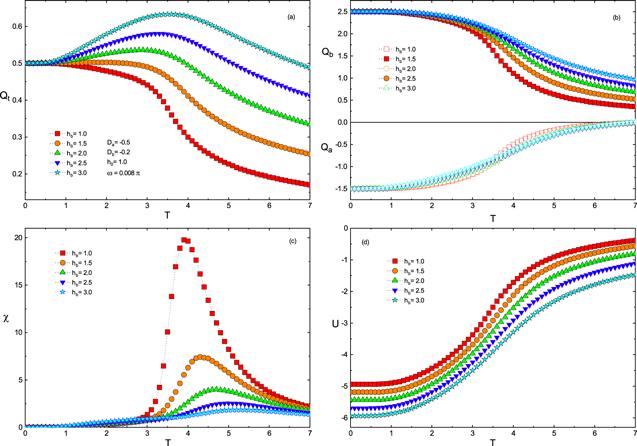 New window|Download| PPT slide
New window|Download| PPT slideFigure 5.The temperature dependence of Qt, Qa, Qb, χ and U for different values of hb with Da =−0.5, Db =−0.2, h0 =1.0, ω =0.008π .
Figure 6 exhibits the Qt, Qa, Qb, χ and U as the function of T for different h0 with fixed values of Da =−0.5, Db =−0.2, hb =0.5, ω =0.008π . It is clearly seen from figure 6 (a) that there is a common saturation value (Qt =0.5) in the Qt curves. Qt decreases monotonically with the increase of T . Specifically, for example, for h0 =2.0, Qt decreases slowly with the increase of T when T <2.2, while it drops sharply at 2.2<T <3.0. When T >3.0, Qt is no longer sensitive to the change of T . This indicates that Qt can be mostly affected by T during middle temperature segment. Qt decreases monotonically with increasing h0 at a given temperature, which is contrary to the effect of hb . Comparable results were also found in La2/3 Ca1/3 MnO3 manganites [42]. One can deduce from figure 6 (b) that the influence of h0 on Qa and Qb is more obvious compared with that of hb, namely, with the increase of h0, Qa and Qb gradually move to the left. It is discovered from figure 6 (c) that TC decreases with the increase of h0, which is also contrary to the effect of hb . This finding is in accordance with the expectations. It is because of the fact that the magnetic energy originating from the external field dominants against the energy provided by exchange couplings with increasing h0 . On account of this mechanism, the Ising graphene-like monolayer can relax within the oscillation period of the applied field so that the value of TC decreases [66]. It is noteworthy from figure 6 (d) that there occur the fluctuations in the U curves in the low temperature region, because h0 dominates U at low temperature rather than T . When h0 is large (h0 ≥2.0), the external magnetic field oscillates violently and it is easy to cause the energy fluctuations of the system in the low temperature region (T <3.0). When T is higher, T has a dominant effect on the energy of the system and the fluctuations disappear. The results are in great agreement with some previous studies [33, 34, 38, 40, 42].
Figure 6.
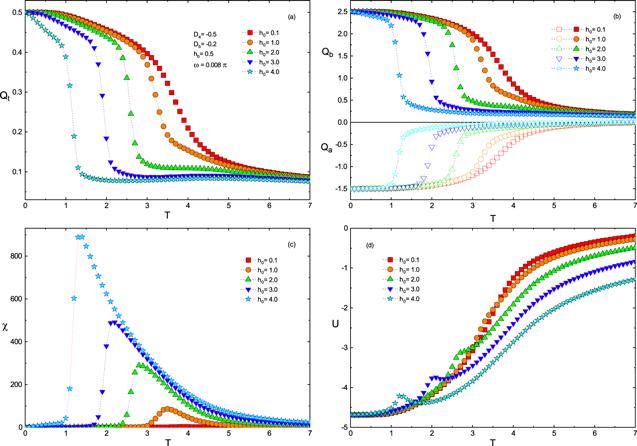 New window|Download| PPT slide
New window|Download| PPT slideFigure 6.The temperature dependence of Qt, Qa, Qb, χ and U for different values of h0 with Da =−0.5, Db =−0.2, hb =0.5, ω =0.008π .
Finally, figure 7 is depicted to show the effect of ω on the temperature dependence of Qt, Qa, Qb, χ and U with fixed values of Da =−0.5, Db =−0.2, hb =0.5, h0 =1.0. In figure 7 (a), it is obvious that Qt is insensitive to the changes of ω when T ≤2.7 or T ≥4.5, while it increases dramatically with the increase of ω when 2.7<T <4.5. This can be explained as follows: when ω is small, the external magnetic field oscillates slowly and the direction of the sublattice spin can follow the time-dependent magnetic field, causing the system in an ordered state with small Qt . When ω is large, the direction of sublattice spin cannot keep up with the change of the external field, which leads to raise Qt and undergo phase transition more difficultly. It is obvious in figure 7 (b) that both Qa and Qb decrease with the decrease of ω and the increase of T . In figure 7 (c), TC increases with the increase of ω although that is not very obvious. In figure 7 (d), it is obvious that U is insensitive to changes of ω . However, from local enlargement one can clearly observe that the larger ω is, the larger U is in the higher temperature region.
Figure 7.
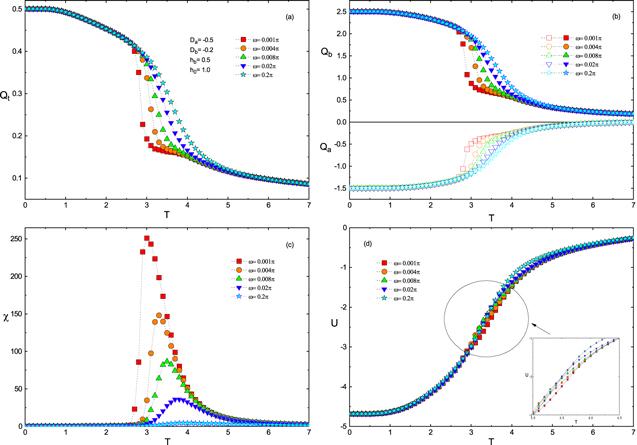 New window|Download| PPT slide
New window|Download| PPT slideFigure 7.The temperature dependence of Qt, Qa, Qb, χ and U for different values of ω with Da =−0.5, Db =−0.2, hb =0.5, h0 =1.0.
3.2. Phase diagram
So as to better elucidate the effects of the various Hamiltonian parameters such as Da, Db, hb, h0 and ω on the TC, the phase diagrams are given in figure 8 . Figures 8 (a) and (b) show the variation of TC as the function of sublattice crystal fields Da and Db . It is obvious that TC decreases monotonically with the increase ofFigure 8.
 New window|Download| PPT slide
New window|Download| PPT slideFigure 8.The temperature dependence of Da, Db, hb, h0 and ω on the critical temperature TC for (a) Db =−0.2, hb =0.5, h0 =1.0, ω =0.008π ; (b) Da =−0.5, hb =0.5, h0 =1.0, ω =0.008π ; (c) Da =−0.5, Db =−0.2, h0 =1.0, ω =0.008π ; (d) Da =−0.5, Db =−0.2, hb =0.5, ω =0.008π ; (e) Da =−0.5, Db =−0.2, hb =0.5, h0 =1.0.
4. Conclusion
In this investigation, the dynamic magnetic behaviors of the mixed-spin (3/2, 5/2) Ising graphene-like monolayer have been studied by employing the MC simulation. The temperature dependence of Qt, Qa, Qb, χ and U for different values of Hamiltonian parameters such as Da, Db, h0, h0 and ω has been exhibited and elucidated in detail. Moreover, particular effort has also been dedicated to the phase diagrams with different planes of parameters so as to further explain the phase transition of the system. We found that Da and Db have similar effects on TC, but h0 and hb have opposite effects on TC . In addition, TC is sensitive to the change of ω only when ω is rather small. We hope that our investigation will contribute to the further study of graphene-like monolayer.Reference By original order
By published year
By cited within times
By Impact factor
DOI:10.1126/science.1102896 [Cited within: 1]
DOI:10.1016/j.spmi.2016.08.005 [Cited within: 1]
DOI:10.1016/j.physleta.2017.10.040
DOI:10.1007/s10825-017-0990-y [Cited within: 1]
DOI:10.1016/j.cej.2014.11.065 [Cited within: 1]
DOI:10.1063/1.4997463 [Cited within: 1]
DOI:10.1016/j.mssp.2017.05.021 [Cited within: 1]
DOI:10.1021/nl505011f [Cited within: 1]
DOI:10.1021/jp060936f [Cited within: 1]
DOI:10.1016/j.cplett.2006.06.081 [Cited within: 1]
DOI:10.1021/ja807449u [Cited within: 1]
DOI:10.1088/0034-4885/73/5/056501 [Cited within: 1]
DOI:10.1038/nnano.2007.451 [Cited within: 1]
DOI:10.1016/j.jmmm.2015.06.009 [Cited within: 1]
DOI:10.1016/j.jmmm.2017.10.045 [Cited within: 1]
DOI:10.1016/j.physa.2018.09.125 [Cited within: 1]
DOI:10.1016/j.jmmm.2010.01.007 [Cited within: 1]
DOI:10.1088/1674-1056/20/6/060507 [Cited within: 2]
DOI:10.1016/j.cjph.2018.12.024 [Cited within: 1]
DOI:10.1016/j.physleta.2016.11.011 [Cited within: 1]
DOI:10.1016/j.carbon.2015.07.097 [Cited within: 1]
DOI:10.1016/j.jmmm.2010.08.030 [Cited within: 1]
DOI:10.1007/s10948-012-1785-9 [Cited within: 1]
DOI:10.1007/s10948-016-3417-2 [Cited within: 1]
DOI:10.1088/0953-8984/23/17/176003 [Cited within: 1]
DOI:10.1016/j.jmmm.2017.01.004 [Cited within: 1]
DOI:10.1103/PhysRevA.41.4251 [Cited within: 1]
DOI:10.1016/j.physa.2015.10.069 [Cited within: 1]
DOI:10.1103/PhysRevE.66.056127 [Cited within: 1]
DOI:10.1016/j.jmmm.2011.11.043 [Cited within: 1]
DOI:10.1016/j.physb.2018.08.053 [Cited within: 1]
DOI:10.1016/j.physa.2012.06.060 [Cited within: 1]
DOI:10.1016/j.physe.2018.09.008 [Cited within: 2]
DOI:10.1016/j.jmmm.2018.04.007 [Cited within: 2]
DOI:10.1016/j.physe.2018.11.043 [Cited within: 2]
DOI:10.1016/j.jmmm.2012.10.024 [Cited within: 2]
DOI:10.1016/j.physa.2018.07.006 [Cited within: 1]
DOI:10.1016/j.physleta.2017.03.012 [Cited within: 3]
DOI:10.1016/j.jmmm.2013.05.024 [Cited within: 1]
DOI:10.1016/j.jmmm.2015.05.001 [Cited within: 3]
DOI:10.1016/j.tsf.2015.07.009 [Cited within: 2]
DOI:10.1016/j.physleta.2018.01.022 [Cited within: 5]
DOI:10.1016/j.carbon.2017.05.052 [Cited within: 1]
DOI:10.1016/j.physe.2019.02.028 [Cited within: 1]
DOI:10.1016/j.spmi.2016.09.013 [Cited within: 1]
DOI:10.1016/j.physe.2018.03.025 [Cited within: 1]
DOI:10.1016/j.physe.2019.01.004 [Cited within: 1]
DOI:10.1016/j.physe.2018.11.038 [Cited within: 1]
DOI:10.1016/j.physa.2011.05.020 [Cited within: 1]
DOI:10.1126/science.272.5268.1596 [Cited within: 1]
DOI:10.1103/RevModPhys.65.851 [Cited within: 1]
DOI:10.1126/science.1138834 [Cited within: 1]
DOI:10.1063/1.1699114 [Cited within: 1]
DOI:10.1016/j.physa.2017.03.029 [Cited within: 1]
[Cited within: 1]
DOI:10.1214/aoms/1177706647 [Cited within: 1]
DOI:10.1016/j.physa.2018.09.089 [Cited within: 1]
DOI:10.1016/j.physe.2019.113721
DOI:10.1016/j.physa.2019.122932
DOI:10.1016/j.jpcs.2019.109110 [Cited within: 1]
DOI:10.1016/j.jmmm.2014.08.094 [Cited within: 1]
DOI:10.1016/j.physa.2020.124741
DOI:10.1016/j.physe.2019.04.012
DOI:10.1016/j.jallcom.2017.01.099 [Cited within: 1]
DOI:10.1016/j.jmmm.2011.08.046 [Cited within: 1]
DOI:10.1016/j.physleta.2013.08.001 [Cited within: 1]
DOI:10.1016/j.physb.2012.08.036 [Cited within: 1]
